INTRODUCTION
This article aims to show didactic photographs as viable agronomic alternative practices. Guar is a legume with low soil fertility requirements and minimum use of irrigation water, considered a drought-tolerant plant, since it takes advantage of summer rainfall during the rainy season for its growth. It should allow enough time for the main wheat crop being stablished on the recommended planting date for each region.
Inoculation with strains of Microsymbiont rhizobium fix nitrogen in roots for more than 300 kilos of nitrogen per hectare. If the inoculum is not available, you can use the collected leaching liquid applied in the irrigation water or sprinkle the vermicompost formed soil of the Californian red worm culture. These applications help guar roots become infected by beneficial bacteria and grow populations reserves in the soil for future crops.
A Legume guar –Grass wheat rotation is planted. Requires contract agreement price in advance.
Principles: Knowing the physiological bases of the crop plant improves the natural resources use. Learn to manage the Guar -Wheat rotation. Guar can be planted at a density of 100 plants per linear meter. The crop grows to a height greater than 120 centimeters. Each bean gives a pod with 5 to 12 grains of variable color from white, pink, gray and black, mostly creamy.
The crop responds very well to organic fertilizers that modify and give structure to the soil, decompose straw and roots, improving aeration and drainage of the soil, forming natural humic acid. Applying 15 Kg per hectare of commercial humic acid, a yield of 4 tons of grain per hectare and 18 Ton/Ha of straw with a 9% crude protein content is achieved. Lowering the planting density, no fertilizers to the soil and not supporting with humic acid applications the yields will be only 1.4 Ton/Ha. in threshing grain and dry forage of 5 tons per hectare.
The plant must be completely dry so that the fibrous stem can be cut and does not become entangled in the thresher. The dry pods with natural moisture so that the senescence does not fly the grains out of the thresher and will not be harvested.
Description:
Guar seed is used as a binder in sausages and canned meat, soft drinks, and confectionery. It is a thickener and gelatinized since it modifies the viscosity of foods, ice creams, dressings, and too many other food applications.
In animal feed, it is a substitute for soybean meal paste. It does not cause adverse effects, it does not alter blood serum, it does not modify feed efficiency it keeps carcass meat quality in pigs with saturated fatty acids. It is an excellent alternative to control diarrhea, solving the lack of zinc oxide ZnO , copper sulfate CuSO4 and antibiotics in the diet, products that now have been eliminated in the international market.
A poorly balanced diet using guar can reduce daily consumption and therefore daily weight gain and final weight goals or egg and milk production rates. To counteract this negative effect on consumption, the grain can be hydrolyzed at high temperature using different methods dry, with steam or under pressure or making extruded crumbles. Also, the gelatinization of cereals (puffed wheat, corn flakes, popcorn, white rice, steamed sorghum) improves digestibility and makes them suitable for consumption by new born calf, suckling piglets, recently weaned lactating pig and day one chicks. With the temperature process on guar grain and physical properties changes, trypsin and growth inhibitors and anti-nutritional factors are eliminated, it also improves fiber digestibility and have a minimizing effects of early diarrhea in young animals. That is the reason for this article. Motivate the production of guar crop and feed demand.
Guar has a prebiotic intestinal activity on the growth of bacteria. It increases Clostridium populations butyricum sensi and bifidobacteria that produce butyrate, short-chain fatty acids; lactate, acetate and propionate. With a decreasing direct effect against the abundant detrimental populations of Escherinchia , Sigella and Fusobacteria , thus causing fewer toxic metabolites, less ammonia, reducing indole and skatole levels in intestinal excrement. Guar carbohydrates are not digestible in the stomach; they are fermented in the colon since they are not hydrolyzed by the pancreatic enzyme amylase. They are highly degraded by enzymes of beneficial fauna (bacteria) in the small intestine.
A similar guar prebiotic effect product used in the feed is the starch resistant to digestion extracted from the potato and used as a desiccant for newborn piglets. This can be fed at an early stage of development too.
Guar grain has 60% crude protein, 10% fiber, but it is low in essential amino acids that need to be supplemented in equilibrium in the diet, the grain was not included in the 2012 NRC, it is not very palatable and contains antinutritional factors like many other legumes including soybeans. Today it is necessary to find alternatives that reduce diarrhea in small animals (laying pullets chicks, day old broilers, suckling piglets, calves from dairy farms, early weaning in meat calf, etc.) since there is an animal growth promoting products restriction use including ractopamine for exporting meat products marketed to China and Europe.
Farm production animals consuming guar have viscous intestinal excreta and together with high fiber feeds cause a volume of satiety in the animal by reducing its daily consumption, but they could be balanced with the addition of synthetic amino acids, as well as the inclusion of fats and oils in the early age diet. Field research is needed for proper consideration.
With the aforementioned information, the field is opened to use the guar grain in the feeding of pregnant adult cows and sows. Its fiber content and viscous effect on excreta could facilitate the duration of labor length. We must look for bibliographical citations on this positive effect.
Guar flour must be processed to extract 20% of the residual gum form of the product, the greater the content or concentration of gum, the consumption is reduced. It can very well replace 25% of soybean meal in small animals and up to 50% in fattening animals over 30-120 kg standing, which have already adapted to its flavor, reaching daily weight gains of more than 850 grams per day. Including 75% guar for soybeans does not change feed efficiency, but it does decrease daily weight gain.
Guar contains a viscous galactomannan polysaccharide that is not starchy, since it has lower metabolizable energy ME. It is composed of 65% mannose, 35% galactose, therefore the diet is also supplemented with oil or fat.
MATERIALS AND METHODS
Land Preparation: With the minimum tillage seeder, the soil is not fallowed and the wheat is planted to one side of the guar rows.
Planting method.Technological Innovation: It is planted in a row in furrows spaced at 80 centimeters, to apply minimum tillage on moist soil, relay wheat planted with a legume (guar) that has already been harvested. With the application of fertilizer doses for wheat and the required irrigation sheets, the harvest residues that remained from the guar decompose easily, its roots and nitrogen nodules.
Planting density: Two bags of certified seed per hectare is recommended or 100 Kg of wheat seed/Ha. For guar is a density of 100 plants for each row meter.
Experimental test: With a minimum tillage seeder, wheat is established on the harvest residues of the guar crop. Herbicides and fallow are not applied. The furrow is planted to one side where there are still stems and trunks of the guar plant.
The passage of machinery and the removal of soil leave out subsoil pests like the blind man's chicken Phyllophaga bruneri (left bottom). Residual ratoon prevents the seed from being placed at the correct depth (pink treated sees of wheat right bottom). It is necessary to supervise frequently how the seeder places the seed into the humid soil depth.
Varieties: Cristalino durum or Harinero whole wheat according to the regional market.
Planting date: Guar is planted in mid-spring in the northern hemisphere, when the nighttime soil temperature is 25°C. Beginning of the month of June, after the threshing of wheat. Wheat is sown in November on guar residuals. See the wheat pink seeds by the minimum tillage equipment (top left picture).
At the beginning top right photo, it looks like a mesh sown, but soon there would be an on time wheat emergency to reach proper density and up to normal average yields up to 7-8 tons of wheat per hectare.
RESULTS
The expected yields of guar are 1.5 tons of threshed grain per hectare in the Yaqui Valley, Sonora Mexico, average expected with the experiences of three cycles. Taking care of the calibration of the thresher, revolutionizing the speed of the cut, lowering the speed of the threshing advance and reaching a good drying of the grain that bursts well in the sieve, 2 Ton/ha can be raised. To improve the results in the harvest, the seed must be inoculated to form a bank of specific nitrogen-fixing bacteria in the field for guar so that in future crop cycles and support soil fertility with the application of humic acids.
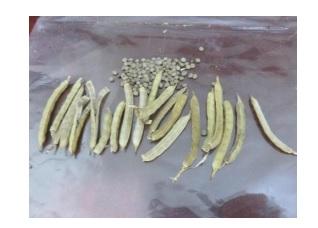
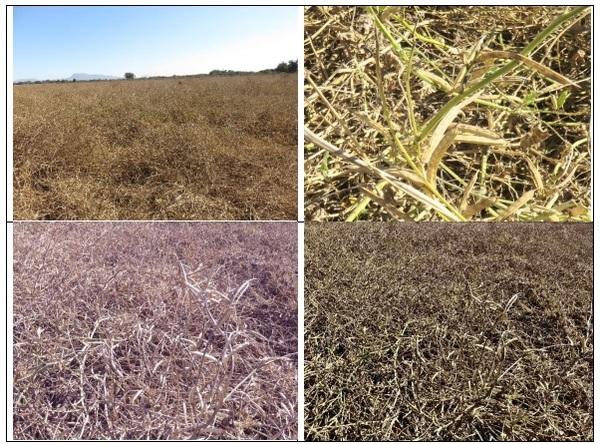
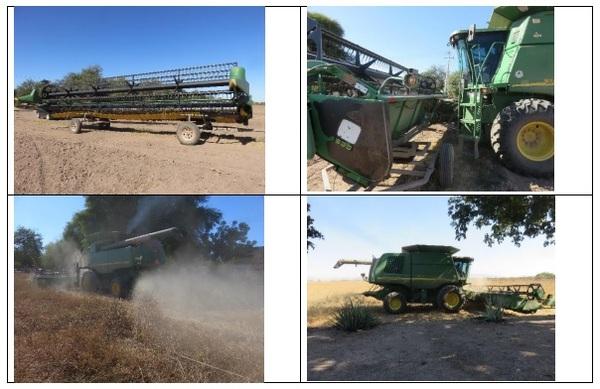
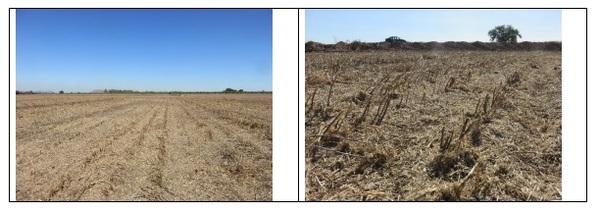
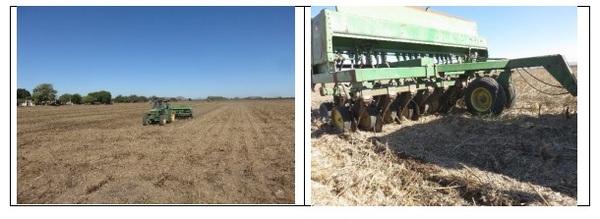
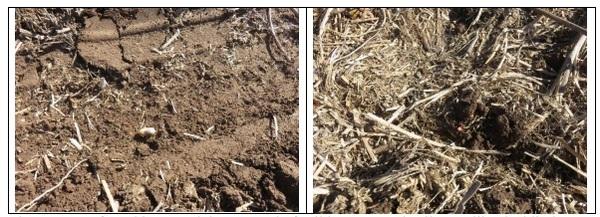








.jpg&w=3840&q=75)